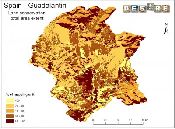| The use of PESERA modelling to guide the choice of Soil and Water Conservation strategies |
 |
|
M.J. Kirkby and B.J. Irvine University of Leeds, Geography, Leeds, United Kingdom
The 18 DESIRE study sites represent a very wide range of climatic conditions, and the climate exerts the strongest single constraint on what are appropriate remedial technologies. Under the various climatic conditions, the greatest constraints on sustainable land use may be through wind or water erosion, water scarcity, wildfires or frost damage, and the choice of appropriate technologies for mitigation of desertification therefore differ between sites, strongly related to the climate associated with their geographical location, but also to local conditions of soil and topography and to deliberate land use choices.
The PESERA model is a physically based, coarse scale model designed to estimate runoff and erosion from the land. It also has the secondary capability to estimate the biomass or crop yield, and the level of organic matter in the soil. These are often of greater economic importance to the farmer than either the on-site or off-site rates of runoff and erosion. The model is driven explicitly by meteorological data, land use and management practices, and by soil type and local relief. In this way it provides a tool for what-if analyses of alternative strategies and scenarios, as well as indicating areas of physical suitability for different land use strategies. Here a simplified version of the PESERA model has been applied to show the dominant types of desertification that constrain agriculture at a regional scale, based on the differences in climate that are the primary drivers of difference.
The balance of dominant risks between sites is compared, both on a map basis and through the level of risk relative to the maximum observed. There is, of course, some additional variation within any area; for example the risks for erosion and overgrazing depend on local relief, so that the hillier parts of any area show increased risks along these axes.
|

Acknowledgement
The DESIRE project was
|
DESIRE brought together the expertise of
26 international research institutes
and non-governmental organisations.
This website does not necessarily
represent the opinion of the
European Commission. The European
Commission is not responsible for
any use that might be made of the
information contained herein. 
